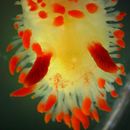Look Alikes
provided by Invertebrates of the Salish Sea
How to Distinguish from Similar Species: Triopha catalinae is also white and orange but it has fewer dorsal outgrowths and the orange spots can be found on the gills and on the dorsum. Okenia rosacea lives mainly farther south and has a rose-pink body.
- license
- cc-by-nc-sa
- copyright
- Rosario Beach Marine Laboratory
Habitat
provided by Invertebrates of the Salish Sea
On rocks, often near bryozoans
- license
- cc-by-nc-sa
- copyright
- Rosario Beach Marine Laboratory
Distribution
provided by Invertebrates of the Salish Sea
Geographical Range: Alaska to Bajia de los Angeles, Baja California, Mexico
- license
- cc-by-nc-sa
- copyright
- Rosario Beach Marine Laboratory
Habitat
provided by Invertebrates of the Salish Sea
Depth Range: Intertidal to 35 m. Mostly subtidal in southern parts of range.
- license
- cc-by-nc-sa
- copyright
- Rosario Beach Marine Laboratory
Comprehensive Description
provided by Invertebrates of the Salish Sea
This dorid nudibranch has a mid-dorsal anus toward the back of the dorsum, surrounded by the gills. The dorsum has many distinctive narrow, unbranched, club-shaped papillae. Those around the margins are longer while those nearer the center of the dorsum are shorter. The body is white or cream-colored and relatively flat, and the gills are short and white and sometimes difficult to see. A network of spicules can often be seen below the surface of the dorsum. Many of the papillae are tipped with bright orange, but the dorsum itself is not and the gills are often not either. The rhinophores are perfoliate and orange for most of their length. Length to 2.5 cm.
- license
- cc-by-nc-sa
- copyright
- Rosario Beach Marine Laboratory
Comprehensive Description
provided by Invertebrates of the Salish Sea
Biology/Natural History: In individuals near the southern end of the range there is a longitudinal row of orange-tipped tubercles or short papillae down the center of the dorsum. In more northern individuals such as this one these central tubercles tend to be white-tipped rather than orange-tipped and are more scattered than in a line, even though the more lateral tubercles and the rhinophores are orange-tipped. This species feeds on bryozoans such as Hinksina velata. Spawning is in spring in our area. Unlike most nudibranchs, the spiral ribbon of eggs that it lays is laid flat against the substrate rather than on edge.
- license
- cc-by-nc-sa
- copyright
- Rosario Beach Marine Laboratory

